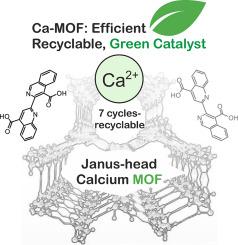An efficient and highly recyclable calcium-based metal-organic framework for green cyanosilylation and hydroboration catalytic reactions
IF 5.4
3区 化学
Q1 CHEMISTRY, INORGANIC & NUCLEAR
引用次数: 0
Abstract
A new calcium-based metal–organic framework (MOF), named GR-MOF-32, with chemical formula {Ca(C20H10N2O4)·2H2O}n ({[Ca(BCA)] 2H2O}n), has been synthesized using the biquinoline ligand 2,2′-bicinchoninic acid (H₂BCA) via a solvothermal method. This MOF is homologous to the previously reported GR-MOF-11 to 14 series (Sr, Y, Cd, Ba) and has been fully characterized through elemental and thermogravimetric analyses, Fourier transform infrared spectroscopy (FTIR), photoluminescence, dynamic light scattering, electrophoretic mobility, and single-crystal and powder X-ray diffraction (SCXRD and PXRD). The structural analysis reveals a highly connected framework that preserves the Janus-head topology of the ligand, similar to its homologous counterparts. The catalytic performance of GR-MOF-32 was evaluated in cyanosilylation and hydroboration reactions showing excellent recyclability, maintaining high catalytic activity all over the seven cycles in both reactions, with only a marginal loss in calcium content and no significant structural changes as confirmed by PXRD and FTIR analysis. In comparison with its homologous catalysts (GR-MOFs 11–14), GR-MOF-32 exhibited superior catalytic performance with a lower catalyst loading (0.2 mol%) and achieved full conversion for most substrates. This study expands the family of GR-MOFs with an s-block metal member such as calcium and highlights the potential of calcium-based MOFs in highly efficient catalyst in both cyanosilylation and hydroboration reactions.

用于绿色氰硅化和硼化氢催化反应的高效、高可回收的钙基金属有机骨架
以双喹啉配体2,2′-双乙酰胆碱酸(H₂BCA)为原料,采用溶剂热法合成了化学式为{Ca(C20H10N2O4)·2H2O}n ({[Ca(BCA)] 2H2O}n的新型钙基金属有机骨架(MOF) GR-MOF-32。该MOF与先前报道的GR-MOF-11至14系列(Sr, Y, Cd, Ba)同源,并通过元素和热重分析,傅里叶变换红外光谱(FTIR),光致发光,动态光散射,电泳迁移率以及单晶和粉末x射线衍射(SCXRD和PXRD)进行了充分的表征。结构分析揭示了一个高度连接的框架,它保留了配体的双面头拓扑结构,类似于其同源对应物。通过对GR-MOF-32在氰硅基化反应和硼氢化反应中的催化性能进行评价,结果表明GR-MOF-32具有优异的可回收性,在这两个反应的7个循环中都保持了较高的催化活性,PXRD和FTIR分析证实,GR-MOF-32的钙含量只有轻微的损失,结构也没有明显的变化。与同类催化剂(gr - mof - 11-14)相比,GR-MOF-32表现出优异的催化性能,催化剂负载较低(0.2 mol%),对大多数底物实现了完全转化。该研究扩展了含有s嵌段金属成员(如钙)的gr - mof家族,并强调了钙基mof在氰硅化和硼化氢反应中作为高效催化剂的潜力。
本文章由计算机程序翻译,如有差异,请以英文原文为准。
求助全文
约1分钟内获得全文
求助全文
来源期刊

Inorganic Chemistry Communications
化学-无机化学与核化学
CiteScore
5.50
自引率
7.90%
发文量
1013
审稿时长
53 days
期刊介绍:
Launched in January 1998, Inorganic Chemistry Communications is an international journal dedicated to the rapid publication of short communications in the major areas of inorganic, organometallic and supramolecular chemistry. Topics include synthetic and reaction chemistry, kinetics and mechanisms of reactions, bioinorganic chemistry, photochemistry and the use of metal and organometallic compounds in stoichiometric and catalytic synthesis or organic compounds.
 求助内容:
求助内容: 应助结果提醒方式:
应助结果提醒方式:


